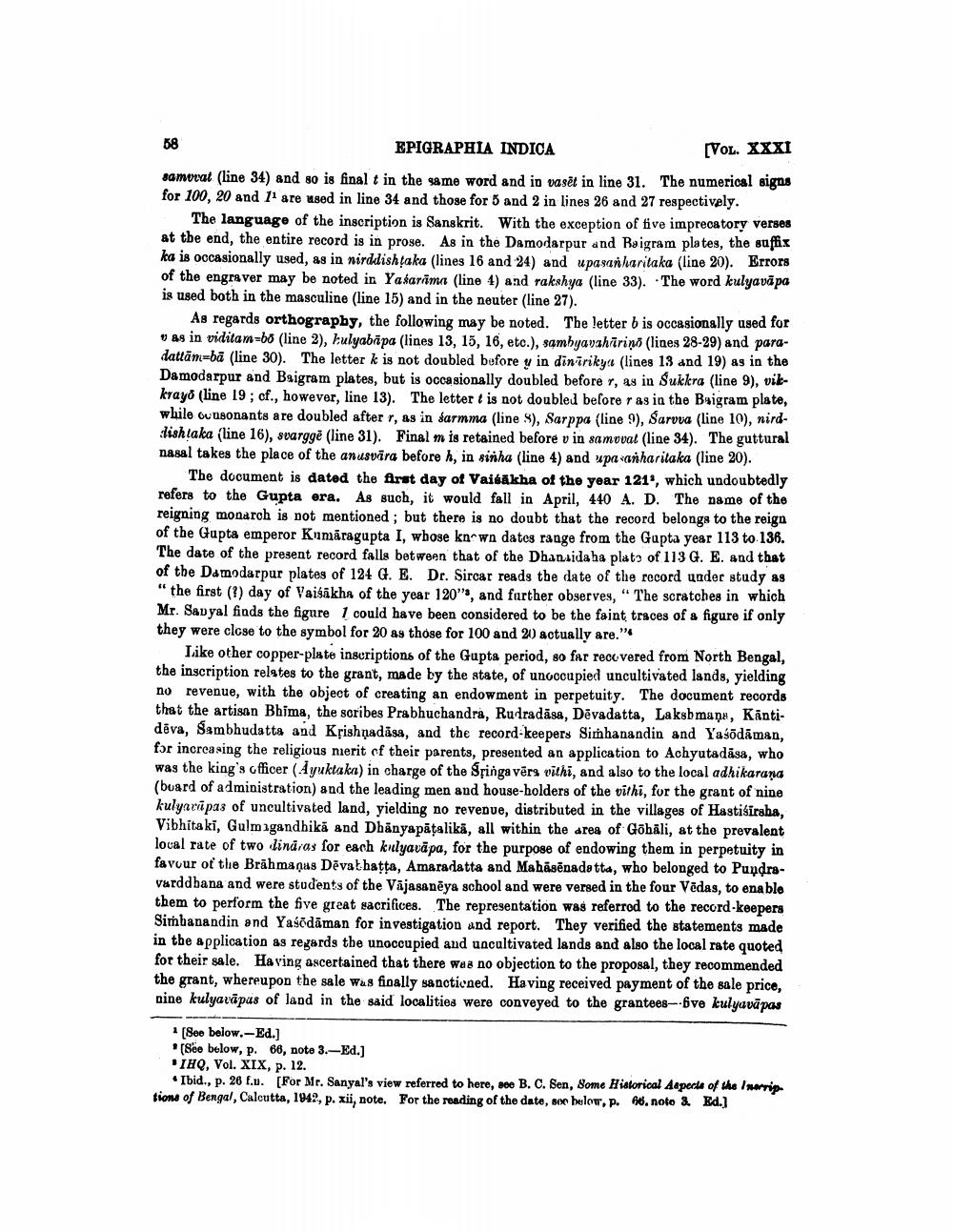________________
58
EPIGRAPHIA INDICA
[VOL. XXXI
samevat (line 34) and so is final t in the same word and in vaset in line 31. The numerical signs for 100, 20 and 11 are used in line 34 and those for 5 and 2 in lines 26 and 27 respectively.
The language of the inscription is Sanskrit. With the exception of five imprecatory verses at the end, the entire record is in prose. As in the Damodarpur and Raigram plates, the suffix ka is occasionally used, as in nirddishṭaka (lines 16 and 24) and upasanharitaka (line 20). Errors of the engraver may be noted in Yasarama (line 4) and rakshya (line 33). The word kulyavapa is used both in the masculine (line 15) and in the neuter (line 27).
As regards orthography, the following may be noted. The letter b is occasionally used for vas in viditam-bo (line 2), kulyabapa (lines 13, 15, 16, etc.), sambyavaharino (lines 28-29) and paradattam-bā (line 30). The letter k is not doubled before y in dinirikya (lines 13 and 19) as in the Damodarpur and Baigram plates, but is occasionally doubled before r, as in Sukkra (line 9), vikkrayo (line 19; cf., however, line 13). The letter t is not doubled before r as in the Baigram plate, while consonants are doubled after r, as in sarmma (line 8), Sarppa (line 9), Sarova (line 10), nirddishtaka (line 16), svargge (line 31). Final m is retained before v in samvvat (line 34). The guttural nasal takes the place of the anusvara before h, in sinha (line 4) and upasanharitaka (line 20).
The document is dated the first day of Vaisakha of the year 121', which undoubtedly refers to the Gupta era. As such, it would fall in April, 440 A. D. The name of the reigning monarch is not mentioned; but there is no doubt that the record belongs to the reign of the Gupta emperor Kumaragupta I, whose known dates range from the Gupta year 113 to 136. The date of the present record falls between that of the Dhanaidaha plats of 113 G. E. and that of the Damodarpur plates of 124 G. E. Dr. Sircar reads the date of the record under study as "the first (?) day of Vaisakha of the year 120", and further observes, "The scratches in which Mr. Sanyal finds the figure I could have been considered to be the faint traces of a figure if only they were close to the symbol for 20 as those for 100 and 20) actually are."
Like other copper-plate inscriptions of the Gupta period, so far recovered from North Bengal, the inscription relates to the grant, made by the state, of unoccupied uncultivated lands, yielding no revenue, with the object of creating an endowment in perpetuity. The document records that the artisan Bhima, the scribes Prabhuchandra, Rudradasa, Devadatta, Lakshmana, Kantideva, Sambhudatta and Krishnadasa, and the record-keepers Simhanandin and Yasōdaman, for increasing the religious merit of their parents, presented an application to Achyutadasa, who was the king's officer (Ayuktaka) in charge of the Sringa vera vithi, and also to the local adhikarana (board of administration) and the leading men and house-holders of the vithi, for the grant of nine kulyarapas of uncultivated land, yielding no revenue, distributed in the villages of Hastiśirsha, Vibhitaki, Gulmagandhika and Dhanyapaṭalika, all within the area of Gōhali, at the prevalent local rate of two lindras for each kulyavapa, for the purpose of endowing them in perpetuity in favour of the Brahmanas Devathaṭṭa, Amaradatta and Mahasenadetta, who belonged to Pundravarddhana and were students of the Vajasaneya school and were versed in the four Vedas, to enable them to perform the five great sacrifices. The representation was referred to the record-keepers Simbanandin and Yasodaman for investigation and report. They verified the statements made in the application as regards the unoccupied and uncultivated lands and also the local rate quoted for their sale. Having ascertained that there was no objection to the proposal, they recommended the grant, whereupon the sale was finally sanctioned. Having received payment of the sale price, nine kulyavapas of land in the said localities were conveyed to the grantees--five kulyavā pas
[See below.-Ed.]
[See below, p. 66, note 3.-Ed.]
IHQ, Vol. XIX, p. 12.
Ibid., p. 26 f.u. [For Mr. Sanyal's view referred to here, see B. C. Sen, Some Historical Aspects of the Inerriptions of Bengal, Calcutta, 1942, p. xii, note. For the reading of the date, see below, p. 66. note 3. Ed.]




